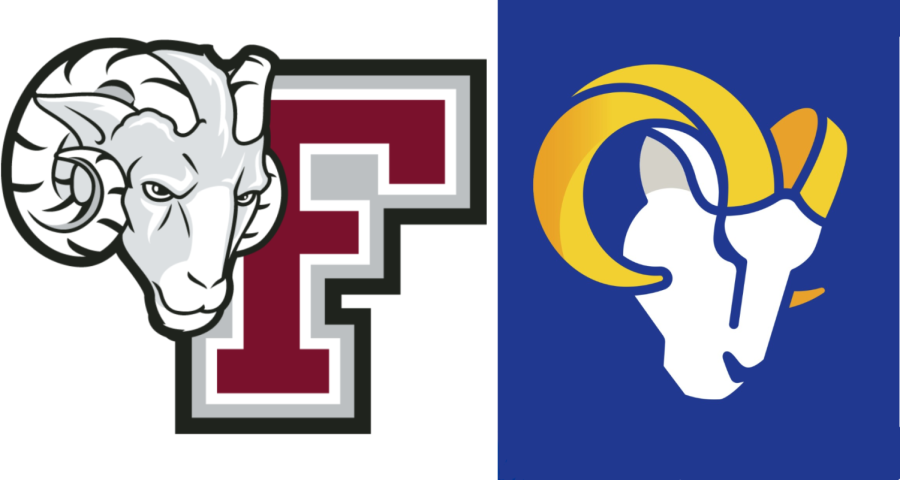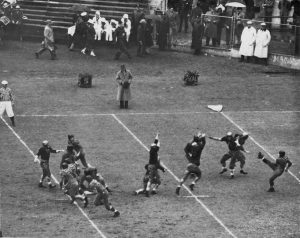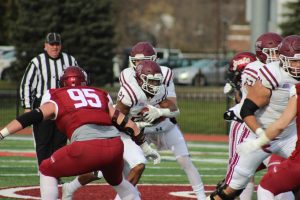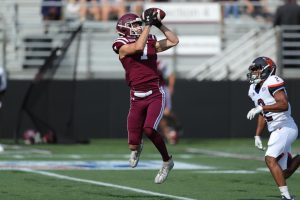How the LA Rams Got Their Name
Inspiration for the Super Bowl competitor’s mascot came from Rose Hill
The Fordham Rams’ mascot was an inspiration to the man who founded the LA Rams, who were at the time located in Cleveland.
February 12, 2022
Correction: A previous version of this article stated that the Cleveland Rams won the Super Bowl in 1945. As of Feb. 14, 2022, it has been changed to reflect that the team won the NFL Championship that year.
The year was 1936, and the American Football League (AFL) was set to embark on its inaugural season.
The league awarded teams to eight cities, but only six would end up joining this ambitious association. One of these lucky cities was Cleveland and, led by player-coach Damon “Buzz” Wetzel, a football franchise was born. Before the players could step onto the field, the new team needed a name. For an answer to this burning question, Buzz turned to one of his favorite college teams: the Fordham Rams.
The thought process behind the team’s name was straightforward. Buzz met with investors and some local reporters to present the issue. The columnists argued that the name should be short in order to make printing headlines easier, so with the name search narrowed slightly, Buzz was given full discretion to choose the name. Someone mentioned the Fordham Rams, and when Buzz agreed, the Cleveland Rams were born.
The Rams have been steadily working to recover the prestige that was lost decades earlier.
It’s hard to imagine our Rams as a household name today, but in the 1930s few colleges were as competitive on the football field as Fordham. In 1935, the United Press released its first-ever national poll of college football teams, and Fordham was ranked 11th in the country. The team dropped to 15th in 1936 but finished with an impressive 5-1-2 record. The 1936 team also featured the powerful offensive line known as the “Seven Blocks of Granite,” which was led by Vince Lombardi and is currently memorialized with a monument outside of Jack Coffey Field.
Fordham’s success would not last forever, however. Following World War II, Rev. Robert Gannon, S.J., sought to reduce the Rams’ status as a prestigious football team. To him, the football team didn’t improve the school, and he wanted to focus on academics. This culminated in a disastrous 1954 season in which Fordham finished 1-7-1, and university administrators disbanded the program.
Football would not return as a varsity sport at Rose Hill until 1970. The Rams finally regained their status as a Division I program in 1989 and, despite 12 straight losing seasons to start their return, have been steadily working to recover the prestige that was lost decades earlier.
Meanwhile, in 1937, the Cleveland Rams parlayed a successful season in the floundering AFL into a move to the thriving National Football League (NFL) that we know today. From there, the Rams struggled immensely. Contrasting Fordham’s success during the same period, the Cleveland Rams did not finish with a winning record in any of their first seven seasons.
In 1945 though, they rebounded and annihilated their competitive NFL opponents. They finished with a 9-1 record and won the NFC Championship game after edging out Washington, 15-14. Immediately following this surprising success, the franchise relocated to Los Angeles due to financial difficulties and a lack of fan attendance.
From 1946 onward, the Rams shifted locations two more times. The first of these was a move to St. Louis in 1995 following a half-decade of lackluster play in the City of Angels. The relocation left Californian fans upset, with one of the main complaints being that the franchise took the beloved Ram mascot and logo with it to Missouri.
The Los Angeles Rams have had a tumultuous history, but one constant has been their horned mascot.
The change of scenery failed to turn things around for the Rams. They failed to compile a winning record in each of their first three seasons, but the winds of change arrived going into the 1998-99 campaign. Led by Kurt Warner and Marshall Faulk, the so-called “Greatest Show on Turf” led the Rams to two Super Bowls in the next three years, hoisting the Lombardi Trophy after the 1999 season. The success was short-lived, however, and from 2005 to 2015, the Rams went 63-128.
The poor performance on the field — combined with a litany of issues with the team’s stadium in St. Louis — prompted another relocation across the country to SoFi Stadium in Los Angeles after the 2015 season.
This brings us to the present day. The Rams, led by quarterback Matthew Stafford, defensive tackle Aaron Donald and Head Coach Sean McVay, are set to play in the 56th Super Bowl against the Cincinnati Bengals, another former AFL squad.
The Los Angeles Rams have had a tumultuous history, but one constant has been their horned mascot. So while the Fordham Rams are mostly removed from their prestigious mid-20th-century status, the storied football team is inextricably tied to one of the most talented teams in the NFL.
Get the latest Fordham sports updates on your Twitter feed. Follow The Observer’s sports Twitter page here.
















Glenn Hendler • Feb 14, 2022 at 12:19 am
I’m not a big sports fan, but I do know the first Super Bowl was in the mid 1960s, so it can’t be right that the Rams won one in 1945…..